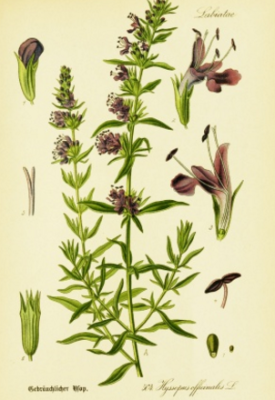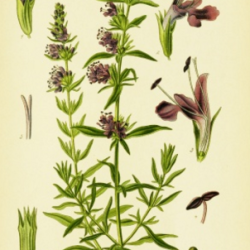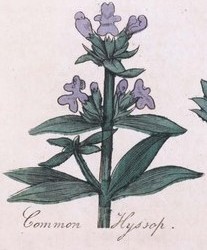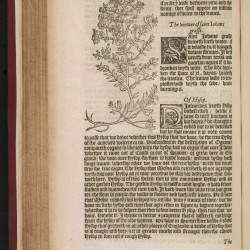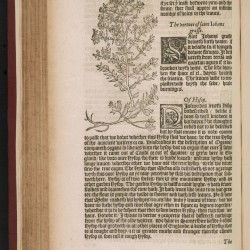Culpeper's The Complete Herbal (1653) - On Hyssop
HYSSOP
“Hyssop is so well known to be an inhabitant in every garden, that it will save me labour in writing a description thereof. The virtues are as follow.
[Government and virtues] The herb is Jupiter’s, and the sign Cancer. It strengthens all the parts of the body under Cancer and Jupiter; which what they may be, is found amply described in my astrological judgment of diseases. Dioscorides saith, that Hyssop boiled with rue and honey, and drank, helps those that are troubled with coughs, shortness of breath, wheezing and rheumatic distillation upon the lungs; taken also with oxymel, it purges gross humours by stool; and with honey, kills worms in the belly; and with fresh and new figs bruised, helps to loosen the belly, and more forcibly if the root of Flower-de-luce and cresses be added thereto. It amends and cherishes the native colour of the body, spoiled by the yellow jaundice; and being taken with figs and nitre, helps the dropsy and spleen; being boiled with wine, it is good to wash inflammations, and takes away the black and blue spots and marks that come by strokes, bruises, or falls, being applied with warm water. It is an excellent medicine for the quinsy, or swellings in the throat, to wash and gargle it, being boiled in figs; it helps the tooth-ache, being boiled in vinegar and gargled therewith. The hot vapours of the decoction taken by a funnel in at the ears, eases the inflammations and singing noise of them. Being bruised, and salt, honey, and cummin seed put to it, helps those that are stung by serpents. The oil thereof (the head being anointed) kills lice, and takes away itching of the head. It helps those that have the falling sickness, which way soever it be applied. It helps to expectorate tough phlegm, and is effectual in all cold griefs or diseases of the chests or lungs, being taken either in syrup or licking medicine. The green herb bruised and a little sugar put thereto, doth quickly heal any cut or green wounds, being thereunto applied.”
Source: The Project Gutenberg EBook of The Complete Herbal, by Nicholas Culpeper, [95]
